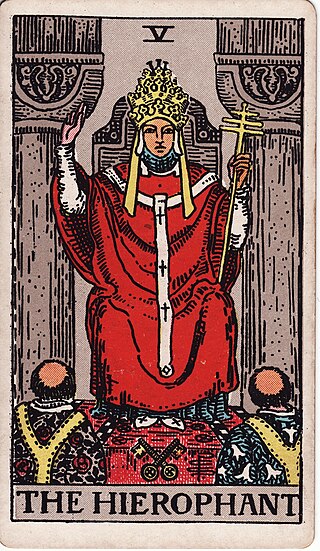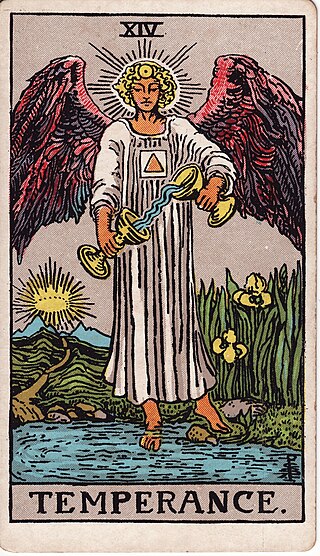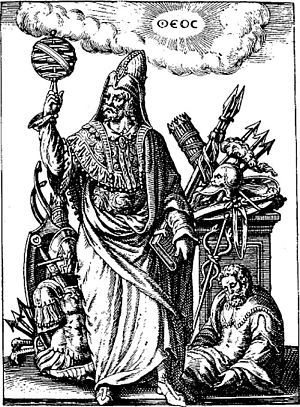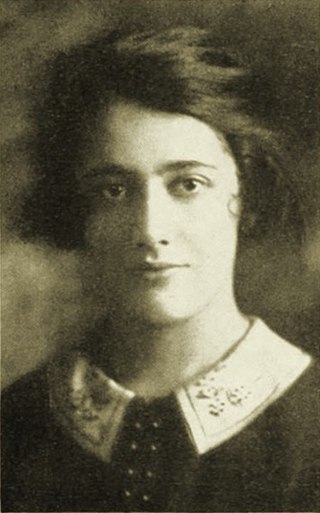Related Research Articles

The Major Arcana are the named cards in a cartomantic tarot pack. There are usually 22 such cards in a standard 78-card pack, typically numbered from 0 to 21. Although the cards correspond to the trump cards of a pack used for playing tarot card game, the term 'Major Arcana' is rarely used by players and is typically associated exclusively with use for divination by occultists.

The Magician (I), also known as The Magus or The Juggler, is the first trump or Major Arcana card in most traditional tarot decks. It is used in game playing and divination.

The High Priestess (II) is the second Major Arcana card in cartomantic Tarot decks. It is based on the 2nd trump of Tarot card packs. In the first Tarot pack with inscriptions, the 18th-century woodcut Tarot de Marseilles, this figure is crowned with the Papal tiara and labelled La Papesse, the Popess, a possible reference to the legend of Pope Joan.

The Empress (III) is the third trump or Major Arcana card in traditional tarot decks. It is used in card games as well as divination.

The Hierophant (V), alternatively depicted as The Pope or The High Priest (as a counterpart to "The High Priestess") is the fifth card of the Major Arcana in occult Tarot decks used in divination. It was identified as the Pope in early decks like Tarot of Marseilles, while modern decks like Rider–Waite Tarot may use the term hierophant (Ancient Greek: ἱεροφάντης), a person who brings religious congregants into the presence of that which is deemed "holy".

Death (XIII) is the 13th trump or Major Arcana card in most traditional tarot decks. It is used in tarot card games as well as in divination. The card typically depicts the Grim Reaper, and when used for divination is often interpreted as signifying major changes in a person's life.

Pamela Colman Smith, nicknamed "Pixie", was a British artist, illustrator, writer, publisher, and occultist. She is best-known for illustrating the Rider–Waite tarot deck for Arthur Edward Waite. This tarot deck became the standard among tarot card readers, and remains the most widely used today. Smith also illustrated over 20 books, wrote two collections of Jamaican folklore, edited two magazines, and ran the Green Sheaf Press, a small press focused on women writers.

The Hanged Man (XII) is the twelfth Major Arcana card in most traditional tarot decks. It is used in game playing as well as in divination.

Strength is a Major Arcana tarot card, and is numbered either XI or VIII, depending on the deck. Historically it was called Fortitude, and in the Thoth Tarot deck it is called Lust. This card is used in game playing as well as in divination.

Justice is a Major Arcana tarot card, numbered either VIII or XI, depending on the deck. This card is used in game playing as well as in divination.

Temperance (XIV) is one of the 22 Major Arcana cards in Tarot decks. It is usually numbered 14. It depicts a figure which represents the virtue Temperance. Along with Justice and Strength, it is one of three Virtues which are given their own cards in traditional tarot. It is used in both game playing and in divination.

The Queen of Cups is a card used in Latin-suited playing cards. It is the queen from the suit of cups. In Tarot, it is part of what tarot card readers call the "Minor Arcana".

The Ace of Wands is a tarot card of the Minor Arcana, arcana being Latin for mysteries. The cards of the Minor Arcana are considered to be lesser compared to the Major Arcana because they discuss the minor mysteries of life, less important archetypes. Modern tarot readers interpret the Ace of Wands as a symbol of optimism and invention.

Hermetic Qabalah is a Western esoteric tradition involving mysticism and the occult. It is the underlying philosophy and framework for magical societies such as the Hermetic Order of the Golden Dawn, has inspired esoteric Masonic organizations such as the Societas Rosicruciana in Anglia, is a key element within the Thelemic orders, and is important to mystical-religious societies such as the Builders of the Adytum and the Fellowship of the Rosy Cross.

Tarot card reading is a form of cartomancy whereby practitioners use tarot cards to purportedly gain insight into the past, present or future. They formulate a question, then draw cards to interpret them for this end. A traditional tarot deck consists of 78 cards, which can be split into two groups, the Major Arcana and Minor Arcana. French-suited playing cards can also be used; as can any card system with suits assigned to identifiable elements.

Sandra Peabody is an American producer, writer, acting coach, talent agent, and retired actress. Peabody is best known for her role as Mari Collingwood in Wes Craven's directorial debut horror film The Last House on the Left (1972), as well as her subsequent career as a producer of children's programming on cable television, which earned her accolades including an Emmy Award and a CableACE Award.

The Fool is one of the 78 cards in a tarot deck. Traditionally, it is the lowest of the 22 trump cards, in tarot card reading called the 22 Major Arcana. However, in tarot card games it developed to be not one of the trump cards but a special card, serving a unique purpose by itself. In later Central European tarot card games, it re-developed to now become the highest trump. As a consequence and with respect to his unique history, The Fool is usually an unnumbered card with a unique design; but sometimes it is numbered as 0 or more rarely XXII. Design and numbering-or-not to not clearly indicate its role as a trump or special card in the specific game.
Lester Cohen was an American novelist, screenwriter and author of non-fiction. He is best known as the author of the novels Sweepings and Coming Home, and the screen play for Of Human Bondage.
Jessie Burns Parke, a notable American artist of the Boston School (painting), has become best known for creating the art for the cards in the Builders of the Adytum (B.O.T.A.) tarot card deck. An oil painter and watercolorist, Parke created both easel paintings and miniatures as well as graphics, etchings, and illustrations. She focused on landscapes, nature scenes, and portraits.

Gertrude Charlotte Moakley was an American librarian and a Tarot scholar. Moakley is notable for having written the earliest and most significant account of the iconography of Tarot, a card game which originated in the Italian Renaissance. She had worked at the New York Public Library.
References
- ↑ "EDEN GRAY". www.chicagotribune.com. January 25, 1999.